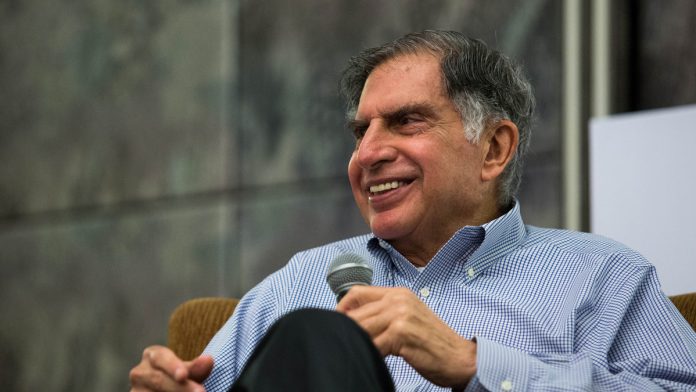Why I find Ratan Tata so inspirational

I feel proud in telling all my readers that I am an ardent fan of Ratan Tata. I am now in my early seventies enjoying my third inning as a freelance advisor, blogger, business consultant, educator, and mentor. During all my classroom sessions with undergraduate and postgraduate students of management, strategy, and entrepreneurship as also during my professional interactions with young corporate executives and aspiring entrepreneurs – I have always been quoting examples of Tata Group and Ratan Tata. They are good exemplars to illustrate my lessons on best business and management practices. The Tatas have always adhered to excellent business ethics and corporate governance practices, corporate social responsibility. They are not only good at dealing with all stakeholders with earnest and fairness but also at contributing to environmental sustainability, and improving the quality of life of people.
“Once, Nano — one of his pet projects, was mired in controversy about land acquisition for the factory. After the protest of farmers in Singur, West Bengal, his company had to pull out of the state. But after all these happenings, he kept his promise to run this project. Tata’s project was shifted to Gujarat and delivered its promise to build the cheapest car.
A real-life example that demonstrates how serious he has been about keeping his promises.
Today – through this blog post – I am trying to bring about certain business learnings from the business experience of Ratan Tata. There is so much information available about Ratan Sir on the internet and other sources that it was difficult for me to decide as to what I should pick up for this post. I hope what I have finally chosen to include in this post benefits and motivates you.
A few lessons that are worth emulating:
It is great to be a Morning Person:
Early to bed and early to rise makes a man healthy, wealthy, and wise – Going to bed early, say before 10 PM and starting your day early next morning (say 5 AM) helps you better deal with negativity. It enhances your chances of success and makes you more persistent, cooperative, agreeable, conscientious, and proactive. Ratan Tata always believed in being a morning person – he used to convene his important business meetings at 6 AM in the morning to get the best results from these meetings.
Building an Atmosphere of Trust:
According to Ratan Tata – Trust is the psychological bond between you and your customers, employees, and stakeholders. Without trust, you risk becoming a superficial entrepreneur. It is therefore essential that you develop an environment of love, concern, and trust among all members of your enterprise – ensuring that you understand the aspirations and expectations of all your stakeholders and fulfil them.
Building Great Employee Relationships:
You must have a strong connection and nurture excellent relationships with your employees. Ratan Tata followed this religiously. According to him, you must inspire and motivate your employees to get the job done effectively and efficiently. You should also, through your leadership, strive to ensure that employees and management should adhere to the company vision and values.
Humility is a great Leadership Trait:
Ratan Tata has remained a humble man throughout his career. Staying humble made him a great leader and he always put himself grounded. As a result, he could easily serve his organization and its employees according to their interests. This is a great lesson for our current generation of organizational leaders and corporate managers – something worth emulating.
Always having a Positive Attitude:
As an entrepreneur or corporate executive – you must always carry a positive attitude. Ratan Tata always has a positive attitude, and he puts a smile on his face in every situation. He always possesses a positive outlook towards any difficult situation. He always tries to be a doer, not a criticizer.

Risk-taking is important for Entrepreneurs:
Ratan Tata always believes in taking the risk. He thinks that life is not lived unless one takes chances and learns how to survive the odds of new challenges. Once he said, “I don’t believe in making the right decisions. I take decisions and make them right.”
Need for Collaborating and Working together:
Ratan Tata has suggested that Indian companies need to focus more on collaboration in various areas to propel the country instead of focusing only on individual achievements. He says – “If you want to go fast, walk alone but if you want to go far, walk together.” No doubt – that is great business learning.
Learning from the Life Experiences of Others:
The best way to keep your motivational levels rising is by educating yourself from the life experiences of others. Other people’s struggle and their zeal to fight all odds to reach a pinnacle position in real life can be a great deal of inspirational dosage if you too want to attain your goals in life. Great learning indeed – try to learn from your own mistakes and failures as also from the experience of others.
Being A Man of Values:
Ratan Tata believes that a company should be run on principles, not on personalities. He and his company had some core values which they followed all through their journey. He is also well known for promoting financial transparency and intense vetting for grants for projects which help needy people. Furthermore, public safety and welfare are some of their core values which they always followed. This leadership quality has made them one of the most trusted groups worldwide.
Tata Group: A few laurels it has earned
- “The Tata Group is one of India’s most respected business houses founded on ethical values originated by the founding father Jamsethji Nusserwanji Tata. Its five core values are integrity, understanding, excellence, unity, and responsibility. Tata Group’s focus is on social responsibility and ethical business practices. It is committed to giving back to society and improving the quality of life of people and contributing to environmental sustainability. It has a well-established code of conduct and a business excellence model.
- Since its inception, the Tata Group had sought to function with ethics, integrity, social consciousness, and fairness. According to Ratan Tata, these values were an integral part of the group. This was intended to serve as a guide to each employee on the values, ethics and business principles expected of him or her in personal and professional conduct.
- Tata Power has been named as one of the World’s Most Ethical Companies for 2016 by the Ethisphere Institute, USA, for the third successive year. Tata Power constantly works towards fostering an ethical environment through senior leadership involvement, training, and communication.
- In 2017, Tata Steel had been recognized by Ethisphere Institute, a global leader in defining and advancing the standards of ethical business practice. The steel giant has received the coveted recognition for the fifth time.”








































































